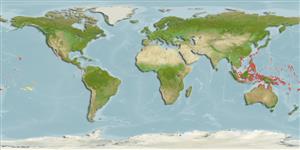Environment: milieu / climate zone / depth range / distribution range
Ecologia
marino associati a barriera corallina; non migratori; distribuzione batimetrica 0 - 3 m (Ref. 30874). Tropical; 30°N - 18°S
Western Pacific: Southern Japan in Ryukyu Islands and south to northern Queensland, Australia. Has been collected close to the islands in Micronesia, Melanesia, Fiji and New Guinea.
Size / Peso / Age
Maturity: Lm ? range ? - ? cm
Max length : 6.4 cm TL maschio/sesso non determinato; (Ref. 117049)
Short description
Chiavi di identificazione | Morfologia | Morfometria
Spine dorsali (totale) : 4 - 6; Raggi dorsali molli (totale) : 8 - 13; Spine anali: 1; Raggi anali molli: 13 - 15. Mouth barely protractile and with thin lips. Basihyal and mesopterygoids usually with teeth. No notch present at the anterior border of preopercular bone. Face with Shangreen denticles. Ascending process of premaxilla with no lateral processes present. Distal end of maxilla blunt and truncate.
Loose aggregations inhabit tide pools and rocky shorelines and reef margins. Eggs are large.
Life cycle and mating behavior
Maturità | Riproduzione | Deposizione | Uova | Fecundity | Larve
Myers, R.F., 1991. Micronesian reef fishes. Second Ed. Coral Graphics, Barrigada, Guam. 298 p. (Ref. 1602)
IUCN Red List Status (Ref. 130435: Version 2024-1)
Threat to humans
Harmless
Human uses
Pesca: di nessun interesse; esca: occasionally
Strumenti
Special reports
Download XML
Fonti Internet
Estimates based on models
Preferred temperature (Ref.
123201): 26.2 - 29.3, mean 28.7 °C (based on 1520 cells).
Phylogenetic diversity index (Ref.
82804): PD
50 = 0.6250 [Uniqueness, from 0.5 = low to 2.0 = high].
Bayesian length-weight: a=0.00389 (0.00180 - 0.00842), b=3.12 (2.94 - 3.30), in cm total length, based on all LWR estimates for this body shape (Ref.
93245).
Trophic level (Ref.
69278): 3.4 ±0.45 se; based on food items.
Fishing Vulnerability (Ref.
59153): Low vulnerability (10 of 100).
Nutrients (Ref.
124155): Calcium = 186 [94, 402] mg/100g; Iron = 0.987 [0.515, 1.791] mg/100g; Protein = 19.2 [16.9, 21.6] %; Omega3 = 0.124 [0.050, 0.339] g/100g; Selenium = 13.5 [6.0, 37.3] μg/100g; VitaminA = 331 [96, 1,081] μg/100g; Zinc = 2.16 [1.34, 3.37] mg/100g (wet weight);
